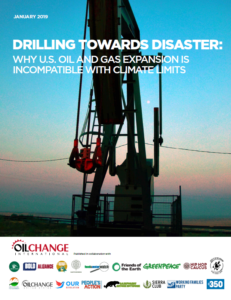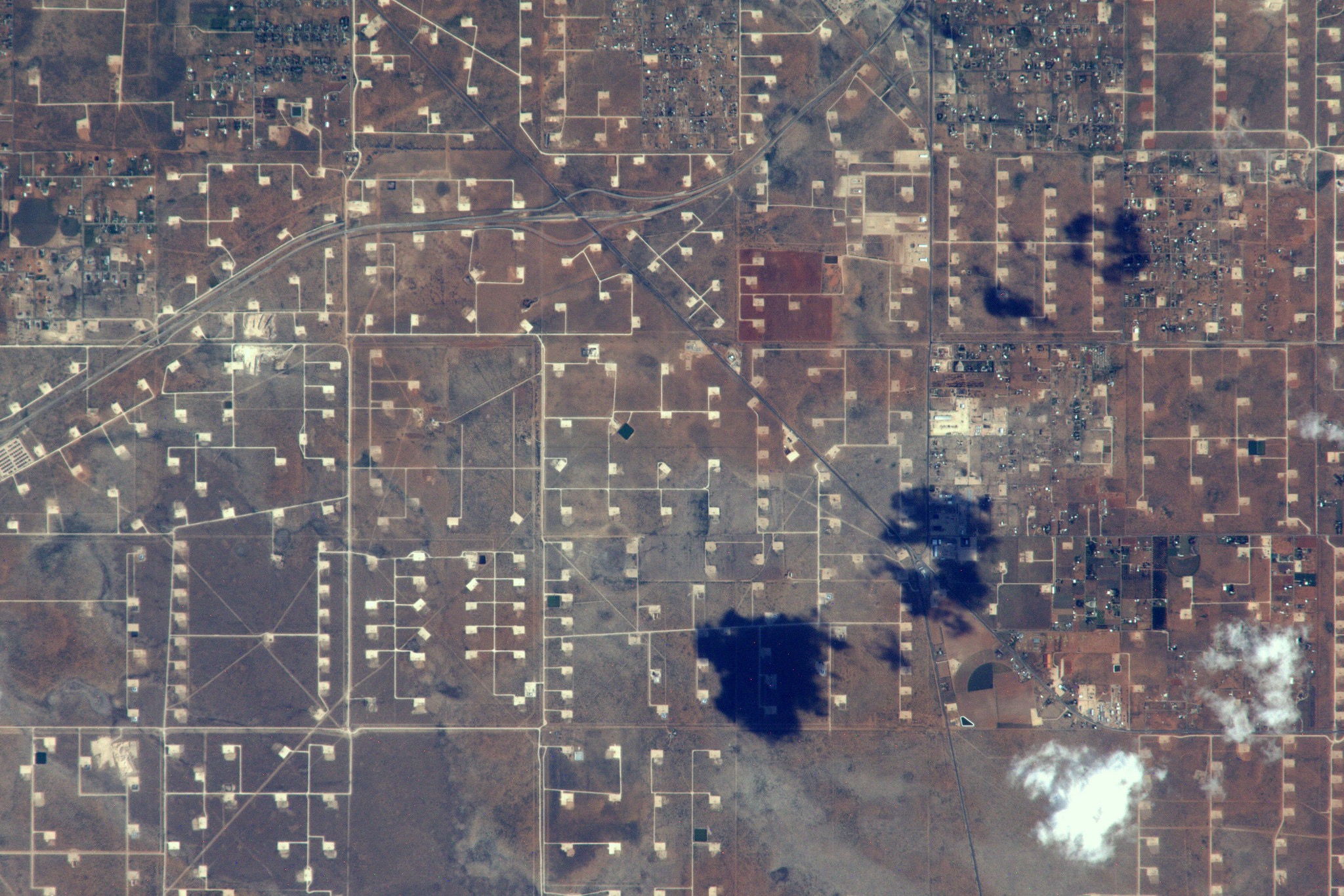 Oil Change International in collaboration with:
Oil Change International in collaboration with:
350.org, Amazon Watch, BOLD Alliance, Center for Biological Diversity, Earthworks, Food & Water Watch, Friends of the Earth U.S., Greenpeace USA, Hip Hop Caucus, Indigenous Environmental Network, Labor Network for Sustainability, Oil Change U.S., Our Revolution, People’s Action, Rainforest Action Network, Sierra Club, Working Families Party
January 2019
Download the full report.
Download selected figures from the report.
This U.S. report is part of a series of publications in the Oil Change International Sky’s Limit series, based on our foundational global report released in 2016: The Sky’s Limit: Why the Paris Climate Goals Require a Managed Decline of Fossil Fuel Production.
——————————————————————
A new study released by Oil Change International and 17 partner organizations examines the urgent need for U.S. leadership to manage a rapid and just decline of fossil fuel production.
The United States should be a global leader in winding down fossil fuel use and production. Instead, the U.S. oil and gas industry is gearing up to unleash the largest burst of new carbon emissions in the world between now and 2050. At precisely the time in which the world must begin rapidly decarbonizing to avoid runaway climate disaster, the United States is moving further and faster than any other country to expand oil and gas extraction.
Key findings include:
- Unprecedented Oil & Gas Expansion: Between 2018 and 2050, U.S. drilling into new oil and gas reserves could unlock 120 billion metric tons of new carbon pollution, which is equivalent to the lifetime CO2 emissions of nearly 1,000 coal-fired power plants. If not curtailed, U.S. oil and gas expansion will impede the rest of the world’s ability to manage a climate-safe, equitable decline of oil and gas production.
- Expansion Hot Spots: Some 90% of U.S. drilling into new oil and gas reserves through 2050 would depend on fracking; nearly 60% of the carbon emissions enabled by new U.S. drilling would come from the epicenters of fracking – the Permian Basin of Texas and New Mexico and the Appalachian Basin across Pennsylvania, West Virginia, and Ohio.
- Coal – Too Much Already: Given U.S. coal mining should be phased out by 2030 or sooner if the world is to equitably achieve the Paris Agreement goals, at least 70% of the coal in existing U.S. mines should stay in the ground.
These findings show that leadership is urgently needed towards a U.S. fossil fuel phase-out that aligns with climate limits, takes care of workers and communities on its front lines, and builds a more healthy and just economy for all in the process.
Key recommendations for what U.S. policymakers must do to show real climate leadership:
- Ban new leases or permits for new fossil fuel exploration, production, and infrastructure;
- Plan for the phase-out of existing fossil fuel projects in a way that prioritizes environmental justice;
- End subsidies and other public finance for the fossil fuel industry;
- Champion a Green New Deal that ensures a just transition to 100 percent renewable energy; and
- Reject the influence of fossil fuel money over U.S. energy policy.


The devil is in the detail of “just transition” which, to me, means Oil & Gas (as well as coal) Boards of Directors must act in the Public and National Interest as they wrestle with exercising Fiduciary Duty to their investors during the endgame, winding down to zero production.
That would entail not impacting negatively the markets, economy and social fabric by their financial decisions in the face of 1) paying down billions of dollars in debt, and 2) spending billions of dollars dismantling and detoxing retired and abandoned assets and infrastructure.
the endgame must be done in a managed and predictable way that does not throw the corporation into bankruptcy and prematurely shuts down necessarily declining production that may go into negative cashflow or loss territory.
This is necessary to avoid unexpected and calamitous undersupply that would bring transportation, heating and industry to an unplanned precipitous halt—supply chains, groceries, commuters, moms and dads delivering kids to school and daily activities, and the like must not be interrupted for the sake of Corporate profits.
Also, in order to avert negative impacts on the stock markets—and hence pensions, superannuation funds, foundations and other institutional investors, as well as ma and pa investors’ life savings—the Oil & Gas (and coal) Corporations must buy back outstanding shares at an equitable fixed share price in such a way that panic sell-off is prevented and Corporate Officers, Board Members, Management and employees are bought out at the end of the line.
This must be done with Corporate earnings, not public funds. Taxpayers and consumers must be held harmless. Annual profits should fund the entire “final expenses” of the industry, with no future bonuses, stock options, dividends or other payouts that diminish the funds available for decommissioning infrastructure and buying back outstanding shares.
The “devil” is that, given current Price-Earnings ratios of the industry, and assuming steadily declining profits and free cash flow, this could take six decades or more, and we don’t have time to wait.
Thus, it is imperative that we begin gigaton scale Carbon Dioxide Removal (CDR) from the atmosphere and oceans, by all means necessary.
The cost of all the various means to draw down carbon into limestone for construction and building materials and products not yet envisioned will be the true price of carbon, which is a revolutionary idea: Setting the price on CO2 at a level that is determined by the physical processes to remove it and put it to good use.
That could actually be a win-win with carbon extraction replacing mineral extraction, whereby limestone created from CO2 where it is needed replaces natural sand and gravel extraction from remote quarries—not such a bad “devil” rather a new profitable industry.
This is all part of Vice President Cheney’s legacy – pushing through regs and undoing others for hydro fracture technology that has led to this situation unimaginable a few years ago: the US becoming the biggest producer of oil and gas. Historically of course USA has been the biggest emitter of GHG and for a time some thought (yours truly included ) that the tide was changing and innovation would win the day. But the lure of cheap gas and SUVs…. and waiting for someone other than ourselves (the government, the corporations) to take climate action…spell doom. Unless…unless we rally and transform our lives and communities post haste
I don’t understand the focus on production. Shouldn’t it be on consumption?
In the U.S., GM and Ford have stopped making most sedans because its customers want SUVs and light trucks which are less fuel efficient.
Aren’t you focusing on the wrong economic end of the problem?
Thanks for checking out the report! And great question – it’s one we think about a lot at OCI. Check out pages 12-14 in the report for more on why supply side matters.
This blog post is a bit old, but it also gets at a lot of the core arguments that have led us to focus our efforts on stopping carbon lock-in: https://priceofoil.org/2015/09/03/a-convenient-lie/.
Decreasing demand is great, but it’s not going to solve the climate crisis by itself – especially not in the timescale we’ve got to work with.
This is an opinion piece and not a research paper. To promote this as research is really just lying.
Mary Marchefka
mmarchefka2004@yahoo.com
I STILL HONESTLY HOPE THAT ONE DAY, WE WILL ALL WAKE UP TO THE DANGERS OF CLIMATE CHANGE AND DO ALL THAT WE CAN TO SAVE OUR PLANET EARTH AND EVERYONE AND EVERYTHING IN IT FROM TOTAL EXTINCTION, GOD-FORBID A MILLION, TRILLION, ZILLION, AD-INFINITUM TIMES!!! AND ONE WAY IS IF EVERYONE EVERYWHERE IN THE WORLD WOULD USE ONLY CLEAN, GREEN ENERGY FROM SOLAR AND WIND SOURCES FOR ALWAYS!!!